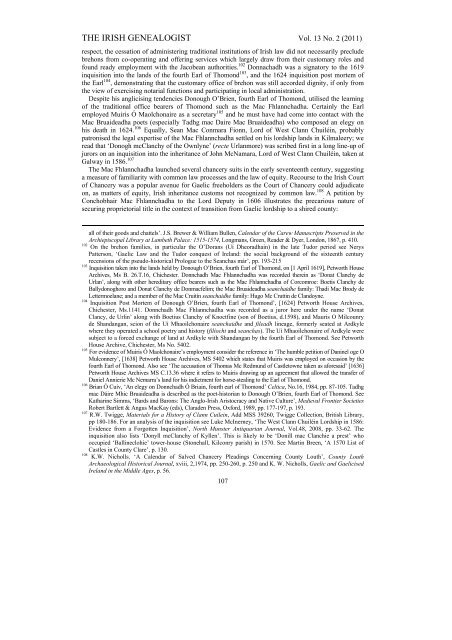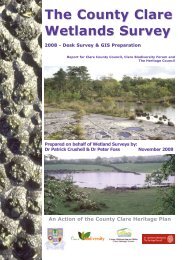A Mac Fhlannchadha Fosterage Document, c.1580 - Clare County ...
A Mac Fhlannchadha Fosterage Document, c.1580 - Clare County ...
A Mac Fhlannchadha Fosterage Document, c.1580 - Clare County ...
You also want an ePaper? Increase the reach of your titles
YUMPU automatically turns print PDFs into web optimized ePapers that Google loves.
THE IRISH GENEALOGIST Vol. 13 No. 2 (2011)respect, the cessation of administering traditional institutions of Irish law did not necessarily precludebrehons from co-operating and offering services which largely draw from their customary roles andfound ready employment with the Jacobean authorities. 102 Donnachadh was a signatory to the 1619inquisition into the lands of the fourth Earl of Thomond 103 , and the 1624 inquisition post mortem ofthe Earl 104 , demonstrating that the customary office of brehon was still accorded dignity, if only fromthe view of exercising notarial functions and participating in local administration.Despite his anglicising tendencies Donough O’Brien, fourth Earl of Thomond, utilised the learningof the traditional office bearers of Thomond such as the <strong>Mac</strong> <strong>Fhlannchadha</strong>. Certainly the Earlemployed Muiris Ó Maolchonaire as a secretary 105 and he must have had come into contact with the<strong>Mac</strong> Bruaideadha poets (especially Tadhg mac Daire <strong>Mac</strong> Bruaideadha) who composed an elegy onhis death in 1624. 106 Equally, Sean <strong>Mac</strong> Conmara Fionn, Lord of West Clann Chuiléin, probablypatronised the legal expertise of the <strong>Mac</strong> <strong>Fhlannchadha</strong> settled on his lordship lands in Kilmaleery; weread that ‘Donogh mcClanchy of the Ownlyne’ (recte Urlanmore) was scribed first in a long line-up ofjurors on an inquisition into the inheritance of John McNamara, Lord of West Clann Chuiléin, taken atGalway in 1586. 107The <strong>Mac</strong> <strong>Fhlannchadha</strong> launched several chancery suits in the early seventeenth century, suggestinga measure of familiarity with common law processes and the law of equity. Recourse to the Irish Courtof Chancery was a popular avenue for Gaelic freeholders as the Court of Chancery could adjudicateon, as matters of equity, Irish inheritance customs not recognized by common law. 108 A petition byConchobhair <strong>Mac</strong> <strong>Fhlannchadha</strong> to the Lord Deputy in 1606 illustrates the precarious nature ofsecuring proprietorial title in the context of transition from Gaelic lordship to a shired county:all of their goods and chattels’. J.S. Brewer & William Bullen, Calendar of the Carew Manuscripts Preserved in theArchiepiscopal Library at Lambeth Palace: 1515-1574, Longmans, Green, Reader & Dyer, London, 1867, p. 410.102 On the brehon families, in particular the O’Dorans (Uí Dheoradhain) in the late Tudor period see NerysPatterson, ‘Gaelic Law and the Tudor conquest of Ireland: the social background of the sixteenth centuryrecensions of the pseudo-historical Prologue to the Seanchas már’, pp. 193-215103 Inquisition taken into the lands held by Donough O’Brien, fourth Earl of Thomond, on [1 April 1619], Petworth HouseArchives, Ms B. 26.T.16, Chichester. Donnchadh <strong>Mac</strong> <strong>Fhlannchadha</strong> was recorded therein as ‘Donat Clanchy deUrlan’, along with other hereditary office bearers such as the <strong>Mac</strong> <strong>Fhlannchadha</strong> of Corcomroe: Boetis Clanchy deBallydonoghoro and Donat Clanchy de Donmacfelim; the <strong>Mac</strong> Bruaideadha seanchaidhe family: Thadi <strong>Mac</strong> Brody deLettermoelane; and a member of the <strong>Mac</strong> Cruitín seanchaidhe family: Hugo Mc Cruttin de Clandoyne.104 Inquisition Post Mortem of Donough O’Brien, fourth Earl of Thomond’, [1624] Petworth House Archives,Chichester, Ms.1141. Donnchadh <strong>Mac</strong> <strong>Fhlannchadha</strong> was recorded as a juror here under the name ‘DonatClancy, de Urlin’ along with Boetius Clanchy of Knoctfine (son of Boetius, d.1598), and Mauris O Milcounryde Shandangan, scion of the Uí Mhaoilchonaire seanchaidhe and fileadh lineage, formerly seated at Ardkylewhere they operated a school poetry and history (filíocht and seanchas). The Uí Mhaoilchonaire of Ardkyle weresubject to a forced exchange of land at Ardkyle with Shandangan by the fourth Earl of Thomond. See PetworthHouse Archive, Chichester, Ms No. 5402.105 For evidence of Muiris Ó Maolchonaire’s employment consider the reference in ‘The humble petition of Daninel oge OMulconnery’, [1638] Petworth House Archives, MS 5402 which states that Muiris was employed on occasion by thefourth Earl of Thomond. Also see ‘The accusation of Thomas Mc Redmund of Castletowne taken as aforesaid’ [1636]Petworth House Archives MS C.13.36 where it refers to Muiris drawing up an agreement that allowed the transfer ofDaniel Annierie Mc Nemarra’s land for his indictment for horse-stealing to the Earl of Thomond.106 Brian Ó Cuív, ‘An elegy on Donnchadh Ó Briain, fourth earl of Thomond’ Celtica, No.16, 1984, pp. 87-105. Tadhgmac Dáire Mhic Bruaideadha is described as the poet-historian to Donough O’Brien, fourth Earl of Thomond. SeeKatharine Simms, ‘Bards and Barons: The Anglo-Irish Aristocracy and Native Culture’, Medieval Frontier SocietiesRobert Bartlett & Angus <strong>Mac</strong>Kay (eds), Claraden Press, Oxford, 1989, pp. 177-197, p. 193.107 R.W. Twigge, Materials for a History of Clann Cuilein, Add MSS 39260, Twigge Collection, British Library,pp 180-186. For an analysis of the inquisition see Luke McInerney, ‘The West Clann Chuiléin Lordship in 1586:Evidence from a Forgotten Inquisition’, North Munster Antiquarian Journal, Vol.48, 2008, pp. 33-62. Theinquisition also lists ‘Donyll mcClanchy of Kyllen’. This is likely to be ‘Donill mac Clanchie a prest’ whooccupied ‘Ballineclohie’ tower-house (Stonehall, Kilconry parish) in 1570. See Martin Breen, ‘A 1570 List ofCastles in <strong>County</strong> <strong>Clare</strong>’, p. 130.108 K.W. Nicholls. ‘A Calendar of Salved Chancery Pleadings Concerning <strong>County</strong> Louth’, <strong>County</strong> LouthArchaeological Historical Journal, xviii, 2,1974, pp. 250-260, p. 250 and K. W. Nicholls, Gaelic and GaelicisedIreland in the Middle Ages, p. 56.107
















